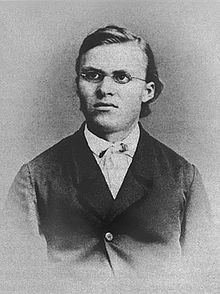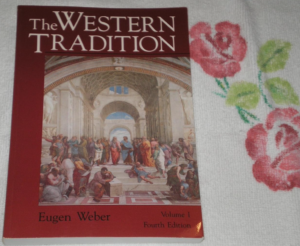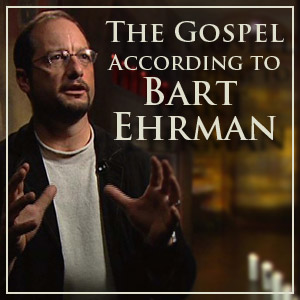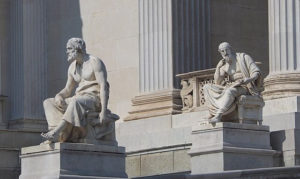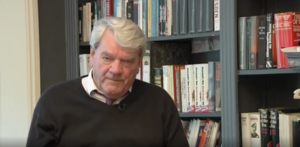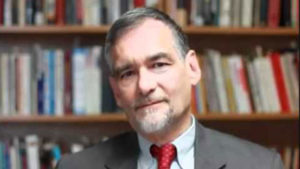vs. Patriarchy, 4
by Eduardo Velasco
Author’s conclusion
European culture as a whole is eminently patriarchal, but even within the West, I believe I can observe the clash between patriarchal and matriarchal mentalities, expressed in the nations possessed by these concepts. Thus, France and Italy, as modern nations, traditionally represent a soft and decadent mentality tending towards matriarchy, while Russia, Germany, England, and the United States represent the more patriarchal and aggressive tendency.
Within our civilisation, it is obvious and undisputable that the two principles are in debate and that patriarchy has been slowly being overturned in favour of a pseudo-matriarchy for some time now.
It also seems obvious to me that patriarchal societies are superior and more advanced than matriarchal societies and, especially, have much greater potential. There is simply no point of comparison in terms of achievements and superiority between the ridiculous pacifist matriarchy and the glorious, all-conquering patriarchy. For me, it is enough to glance over mythology, or to read The Iliad, to feel deep sympathy for authentically patriarchal societies, besides the fact that patriarchy is inevitably associated with Aryan or ‘Indo-European’.

As a sign of the ‘Oedipus complex’ that plagues our civilisation, we have the passions and fears that the word ‘fascism’ arouses in the modern world. What communists, socialists, progressives, democrats and the like hate and fear from ‘fascism’ is the organising severity of a patriarchal society that puts everyone in his place.
What do I think the future of this issue might be? The present abortion of matriarchy is doomed to disappear as soon as the slightest turmoil is unleashed. On the one hand, it has produced a weak society incapable of defending itself and will be overwhelmed by those who have not fallen prey to its scourge (e.g. Islam). On the other hand, the current pseudo-matriarchal society is doomed to extinction for the simple reason that those who profess it don’t preach the need to have children, falling into the most immense contradiction, for a society that believes it is indisputably in possession of the absolute truth (like the current one), should preach offspring to eternalise itself and ensure a future at all costs, in the face of societies that think differently, which are the majority. Over time, his surrealistic utopia will lose ground to the merciless harshness of the times to come, and will eventually be replaced by a patriarchal reaction more in tune with the reality of the world and of man, which is the need for abundant and strong offspring.
The awakening of the white race will, of necessity, be accompanied by a reworking of the old Aryan patriarchy. Sorry to spoil your party, oh herd of decadent Loewe-scented cattle, but the subnormalities are over and so much of what you took for granted is over. There will come a day when you will have to fight to the death just to enjoy the 1% of goods that now seem normal to you! Your disgusting promiscuity, your mental vacuity, your superficiality and your stilted bourgeois sophistication will be extirpated and woe betide you if you cry, stamp your feet or call Superman. Considering the past decadence and the catastrophic situation in which the race—which is the only thing that matters in this world—finds itself thanks to your repellent moral and spiritual baseness, the coming reaction must be exactly the opposite.
By way of Appendix: The peoples of the north and the ‘civilisation of the mother’, from Adriano Romualdi’s La Question d’une Tradition Européenne:
The emergence of a European physiognomy from the mists of High Prehistory took place in the fifth millennium b.c.e. This event was accompanied by a spiritually significant choice: the rejection of the ‘Mother Civilisation’ and the affirmation of the Indo-European Urvolk (‘original people’, German) as an essentially virile and patriarchal community.
The Neolithic, the age of the first agriculture and the first settlements, the age in which families become tribes and tribes become villages, is inaugurated on the European continent with the penetration of the Eastern and Mediterranean elements. These are the Thessalian Sesklo-Dimini cells, heirs of the near-eastern communities that spread up the Danube and proliferated throughout Central and Balkan Europe. This is the so-called Danubian culture, with its banded pottery (Bandkeramik), rough wooden hoes and large collective houses. This culture conveys its spiritual message through small figures depicting a naked female deity. She is Mother Earth (Gê Metêr), the Great Mother of harvests, the dispenser of fertility who holds the keys to life and death. She is the naked goddess, whose kingdom extends from Mesopotamia to Asia Minor, Crete, Malta and beyond. Throughout Western and Atlantic Europe, from the Iberian Peninsula to the British Isles, the dagger-wielding goddess also appears in megalithic engravings. The Eurasian and Euro-African sky of the Mother penetrates, through the Mediterranean race with its Lybian, Ligurian, Iberian and Pelasgic proliferations, to the heart of the European continent.
However, the Mother’s domain does not extend as far as northern Europe. This is the region around the southern Baltic, the area of the beech, yew, birch, and spruce; the area of the wolf, the bear, the salmon, the beaver; the territory that linguistic geography presupposes for the Indo-European Urheimat (‘original home’, German). It is also the territory of the Nordic race where, from the beginning of the 5th millennium, local groups of hunters and fishermen, heirs of the Magdalenian community of the Ice Age, reorganised themselves into a new agricultural culture alien to the world of the Danubians and the Great Mother.
The Norse megalithic culture, with its great stone tombs bearing witness to a firm political and gentile structure, together with its two offshoots, the culture of globular amphorae and the culture of chorded pottery, constitute the original matrix of the Indo-European languages and are responsible for a violent transformation that will affect Europe and vast regions of Asia.
From 3200 b.c.e. onwards, the whole of central, eastern and Balkan Europe was raided by the Northern Peoples. The Globular Amphorae Culture and the Stringed Pottery Culture, departing from their headquarters in the Germanic plain, invade the peaceful communities of the Motherland with their hammer axes, transforming the archaeological picture as far as Greece and Ukraine.
Significantly, this irruption was accompanied by the irruption of solar symbols. The Swastika was born, the oldest example of which appears on a ceramic from the Globular Amphorae Culture found in Poland; the radiated cross and the squared discs, with a dot in the centre or surrounded by rays, were born.
This is a vast symbolic range that finds its greatest flowering in Troy, the frontier city between Europe and Asia, marking the passage of Indo-European peoples into Asia Minor. The Swastika, the primordial symbol of generation and the resurrection of light is associated with the first appearance of the Indo-European peoples in the heart of the fourth millennium, and only fifteen hundred years later it reached India and China.
In the heart of Anatolia, the tombs of Alaja Hüyük, as a prelude to the future splendour of the Hittite kingdom, show us, alongside hammer-headed pins of the northern barbarians, banners decorated with swastikas and other solar symbols. One of these banners features a large stag in the middle of two smaller bulls. We are witnessing the subjugation of telluric, southern, maternal symbolism.
The bull, a symbol of the blind generative force, linked to the ideology of fertility, crudely represented alongside the naked goddess in the most archaic European agricultural cultures, is contrasted with the deer, the animal of the hunters of the North, Seelentier des nordischen Menschen (‘animal of the soul of Nordic men’, German) and, according to Weisweiler, ‘animal of the Arctic civilisation’.
The deer is significantly associated with the symbolism of the sun and light:
Den Sonnenhirsch sah ich von Süden her gehen
Seine Füsse standen auf der Erde
aber die Hörner reichten zum Himmel
These verses of The Edda are illustrated by several prehistoric figures, starting with those from Valcamonica, in which the stag’s horns are stylised in the form of a sun disc.
Similarly, it is significant that in Ireland, when the Celtic element meets the aborigines of Iberian stock, the stag and the bull play a central role in the sagas. Where the words oss, dag and ag, which in the Leinster saga name the stag, in the Ulster saga have come to mean bull.
Behind this clash of symbols, behind the spread of the battle-axe peoples and the spread of the Indo-European languages, lies an event of great spiritual significance.
The paternal principle is pitted against the ‘Mother Civilisation’; Olympian virility against the taurine and maternal myth of fertility; the ethos of the ‘societies of men’ against the enthusiastic promiscuity of ancient Matriarchy.
The echoes spread throughout Europe, where more than a thousand years later, Doric and Latin migrations would create the premises of the classical view of life. But, even more, the effects of this sudden expansion of the Nordic, white and Indo-European stock are felt in the most distant centres of irradiation: on the plateaus of Persia and the threshold of India.


